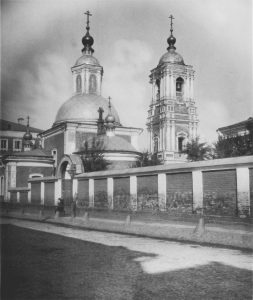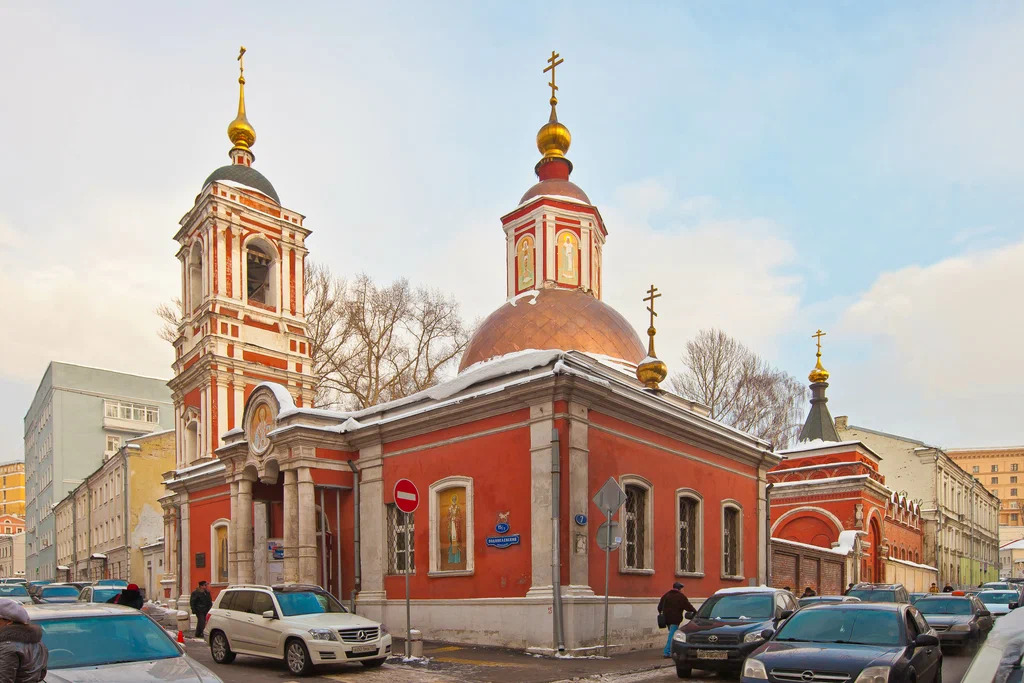Church of St. Nicholas the Wonderworker in Podkopaye

Church of St Nicholas the Wonderworker in Podkopay is an Orthodox church of the Bogoyavlensky sub-district of the Moscow Diocese. The church is located in the White City in the Basmanny district of the Central Administrative District of Moscow (at the corner of Podkopaevsky and Podkolokolny lanes, not far from Khitrovskaya Square). The main altar is consecrated in honour of the Kazan Icon of the Mother of God; side chapels in honour of the Venerable Sergius of Radonezh, in honour of Nicholas the Wonderworker. The church in honour of St. Nicholas the Wonderworker in Podkopai was first mentioned in 1493, when Grand Duke Ivan III Vasilyevich retired here after a fire destroyed his palace in the Kremlin. Restoration studies have shown that the existing quatrefoil of the church was built in the 1550s. It is made of the so-called Groznensky malomer – thin bricks, which were also used in the construction of the side chapels of the Annunciation Cathedral in the Kremlin in the times of Ivan the Terrible. It was mentioned as a stone church in 1657. In 1686 a cemetery was built at the church, and it is mentioned as a stone church, and it is called the church of Nicholas the Wonderworker of Podkopaev. In 1722 the church had two altars: in the name of the icon of the Mother of God of Kazan and Saint Nicholas the Wonderworker. In the XVIII – early XIX century the main altar was consecrated in honour of the icon of the Mother of God of Kazan. In 1731 the church was rebuilt by Anastasia Ermolaevna, the widow of Count Andrei Matveev. In 1748 the church was damaged by fire. In 1750 the Kazan side chapel was renewed at the expense of the Moscow 1st guild merchant Alexei Gubin. In 1759 the existing bell tower was built. Before the French invasion there were three altars in the church: in the name of the icon of the Mother of God of Kazan, Saint Nicholas the Wonderworker and Saint Martyr Catherine. In 1812 the church suffered from the French invasion. After the devastation the church was assigned to the St John the Baptist Church of the Ivanovo Monastery, it was partially restored (the side chapel of St Nicholas the Wonderworker existed until 1842). In the middle of the XIX century came the decision to transfer the church to the Patriarch of Alexandria. In 1855-1858 under the project of architect N.I. Kozlovsky the refectory part of the temple and the side chapels were repaired and partially rebuilt. In 1858 the Church of St. Nicholas in Podkopai was consecrated by Metropolitan Philaret of Moscow and Bishop Nicanor of Thevaida, soon after which a tent chapel was added on the eastern side along the line of Podkolokolny Lane. The Church of St Nicholas the Wonderworker in Podkopai was closed and desecrated in 1932 or 1933. The crosses and chapels of the aisles and the heads of the altars were broken. The church was first used as a dwelling house. Then, until 1990, the area of the former churchyard was at the disposal of the “Polyethylene” plant of the Department of Chemical Industry, which located its tool shop there. The interior of the church was destroyed, the murals were painted over and the volume was divided into two floors. The altars of the aisles, the chapel, the belfry and the presbytery were extended by one-storey buildings at different times. The presbytery housed the design department of the factory (2nd floor) and the dressing room of the toolmakers (1st floor). In the south-eastern corner of the church a one-storey stone technical room was built. The church was returned to the Russian Orthodox Church and rededicated on 29 September 1991. The chapels and crosses of St. Nicholas Church were restored, the ugly additions of the Soviet period were removed. The original paintings in the aisles were restored, the main iconostasis was made. The Chapel of St. Nicholas was restored with a hipped roof and the technical annex on the northern side was dismantled. During the restoration in 1994-1996 (workshop No. 13 of Mosproekt-2) a triangular end of the ancient window opening was discovered in the apse, a ridge (under the crowning cornice) and on the façade of the quadrangle the XVII century kokoshniks were uncovered.
Address: Moscow, Podkopaevsky lane, 15/9, p. 1,2,3,5

